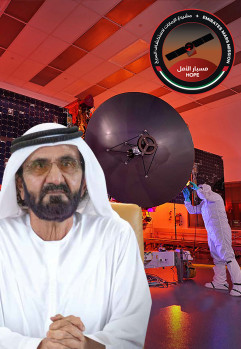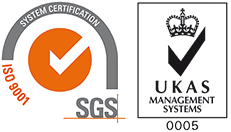Hope Probe: To Write the Name of UAE in the History of Space Science
July 20, 2020, the Arab and Islamic worlds registered the first space achievement; Hope Probe successfully lifted off, from Japan’s Tanegashima Space Centre bringing to life the UAE Project to explore Mars, becoming the first space mission to discover planets led by an Arab country. After the liftoff, the Probe successfully detached from the launch rocket, and the first signals were received by the control center at Al Khawaneej in Dubai.
The first command from the ground control station was also transmitted to the Probe to deploy its solar panels, operate its satellite navigation systems, and launch its missile propulsion systems, effectively marking the start of the Probe’s journey to the red planet. The journey is expected to last seven months, traveling a distance of 493 million km, before entering the Martian orbit in February 2021, coinciding with UAE’s Golden Jubilee celebrations.
The countdown of the last 10 seconds to Hope Probe’s successful liftoff was done in Arabic - the first time in the history of space missions, making the Arabic pronunciation to be heard all around the world.
National Achievement
His Highness Sheikh Khalifa Bin Zayed Al Nahyan, President of the United Arab Emirates, said that the launch of the ‘Hope Probe’ on its historic journey to Mars under the slogan of “Nothing is impossible” constitutes a national and Arab achievement and an advanced Emirati push in the process of building global knowledge in space.
In his speech on the occasion, His Highness Sheikh Khalifa said, “We followed with great pleasure and pride today the news of the successful launch of Hope Probe, whose idea was developed within our national and research institutions and was designed and manufactured with the effective participation of a young national elite of bright minds - highly qualified and trained and sincere young Emiratis.”
His Highness added, “Hope Probe represents another high-quality, high-value addition to the UAE’s outstanding achievements that will enter history as a source of pride for the UAE and its people.”
Concluding his speech, Sheikh Khalifa said, “On this glorious day, we remember the late Sheikh Zayed bin Sultan Al Nahyan, and his brothers, the founding fathers of the UAE, who laid the solid foundation for a country capable of moving towards the future in confidence and appreciation.”
His Highness Sheikh Mohammed bin Rashid Al Maktoum, Vice President, Prime Minister of the UAE and Ruler of Dubai said that the UAE is entering history with an unprecedented Arab space achievement, pointing out that the bet on the UAE’s youth is always a success. His Highness added that the journey has begun, the mission is at its beginning, and the next station is the red planet, stressing that leaving the Earth’s gravitational field is entering a new phase in the history of our scientific achievements.
On his part, His Highness Sheikh Mohamed Bin Zayed Al Nahyan, Crown Prince of Abu Dhabi and Deputy Supreme Commander of the UAE Armed Forces, said UAE has strengthened its position as a country that creates the future and embraces hope, and congratulated the UAE people on the historic achievement, adding that UAE’s global position is getting stronger thanks to the people of our nation.
He added that, “The success of this launch is a culmination of five decades of accomplishments across different fields for the UAE. Today, we’re reaping what our founding fathers have sowed by creating qualified Emirati talents which is helping us compete with the world,” further stressing that, “The UAE is winning the bet, and our people have proved their ability to achieve the impossible. The future is much greater and better.”
Mission Launch
Hope Probe was carried by a 53-meter long and 289-tonne H-IIA rocket developed by Mitsubishi Heavy Industries.
In the initial stage of the launch, the solid fuel propellant lifted the rocket after detaching from the launch pad, before the first stage separation traversing the dense lower atmosphere.
With the separation of this part, the weight of the Hope Probe rocket decreased, to begin a period of zero gravity, and then the second part of the launch rocket was separated, to start the second stage until the Hope Probe reached its correct orbit around Mars, loaded on the third part of the launch missile.
The journey is expected to
last seven months, traveling
a distance of 493 million
km, before entering the
Martian orbit in February
2021, coinciding with UAE’s
Golden Jubilee celebrations.
The Hope Probe was successfully launched from the Tanegashima Space Center in Japan at 01:58 am on July 20. It separated from the launching rocket after less than an hour, so that it could operate automatically. It opened the solar panels at 03:00 am after the panels had been cocked with the probe towards the sun.
The first broadcast signal from Hope Probe was recorded at 03:10 am Emirates time after the probe turned on its broadcast device, and then the Al Khawaneej Control Center began receiving the first data that the probe sent about an hour after the launch, and the work team at the center analyzed the data. This data is preliminary to confirm the state of the Hope Probe and the position of the solar panels, and whether they have opened correctly and completely, as well as verify that the probe is correctly aimed towards the sun.
The initial analysis of the data received from the Hope Probe took about half an hour, and accordingly, orders were sent to the spacecraft from the control center, according to which the probe moved to the operations stage.
The Al Khawaneej Control Center team monitored the processes, data and coordinates of the probe’s condition to ensure that the main Hope Probe operation system is sound, a s well a s verify the integrity of subsystems and scientific devices.
The separation of the Hope Probe from the launch missile constitutes an important step and a great incentive for the team to do more during the next stage, as the probe’s mission to explore Mars translates the state slogan that Hope Probe carried on its historic space flight; “nothing is impossible.”
Preparation and Launch Stages
Hope Probe arrived at the Tanegashima Space Center in April after an 83-hour trip, by land, sea and air. It underwent high-precision testing and launch operations, which included filling the fuel tank for the first time with about 800 kg of hydrogen fuel and checking the fuel tank and making sure that there are no leaks.
Furthermore, testing communication and control devices was done before the spacecraft was moved to the launch pad and later installed on the rocket that carried it into space. The Hope Probe’s batteries were then charged for the last time.
Final tests also included the examination of the power system, communication system, navigation system, control system, propulsion and driving system, thermal system and software systems.
The launch of the Hope Probe was preceded by three basic processing stages; the first being the removal of the exploration camera covers before the missile was installed on the launch pad. The second stage involved moving the missile carrying Hope Probe to the launch platform, which is a complex and delicate process. It took about half an hour and necessitated the separation of the ground control equipment from Hope Probe temporarily so that it could re- activate this equipment when it reached the platform.
The third processing stage was the final preparations, 18 hours before the launch of the probe, which included the withdrawal of nitrogen gas for maintaining the safety of the devices, and clean air in the combustion room in the missile, followed by an examination of the status of the batteries and the state of the probe, as well as ensuring the team’s readiness in the operating room.
The Journey of Hope Probe
The journey of the Hope Probe to Mars will take seven months. It is expected to enter the orbit a round t he Red Planet in February 2021, coinciding with the 50th anniversary of the establishment of the UAE Union.
The separation of the Hope Probe from the missile is a massive step achieved by the efforts of a large team of more than 200 Emirati engineers.
Three months before its launch date, the Hope Probe team representing the Emirates Space Agency and the Mohammed Bin Rashid Space Center was distributed between the launch center in Japan and Al Khawaneej ground control station in Dubai, to complete the final tests and scientific follow-ups. Work on the project was accelerated to overcome the technical and logistical challenges posed by the emergence of COVID-19.
The Hope Probe will remain in the orbit of Mars for a Martian year, which is equivalent to 687 days, as it undertakes a scientific mission being the first of its kind in the world, by providing the first comprehensive data of the climatic conditions on Mars throughout the year, along with researching the causes of fading upper layer of the Mars’s atmosphere, investigating the relationship between the lower and upper atmosphere layers on Mars, observing atmospheric phenomena on the surface of Mars, including monitoring dust storms, temperature changes, revealing the underlying causes of the erosion of the Martian surface, and searching for any relationships between current weather and previous climatic conditions in the red planet.
The Hope Probe will remain
in the orbit of Mars for a
Martian year, which is
equivalent to 687 days, as
it undertakes a scientific
mission being the first of
its kind in the world
The scientific data collected by Hope Probe will be deposited in a center for scientific data in the UAE where the Emirati scientists will classify and analyze this data, and share it for free with the specialized scientists and researchers all over the world to support human knowledge.
Scientific Heritage
In addition to the interim qualitative achievements of the UAE team to explore Mars, which included, in recent months the transfer of the probe successfully on a journey that took 83 hours by land, air and sea from the Mohammed Bin Rashid Space Center to the launch station on Tanegashima Island, Japan. The achievements of the UAE scientific team in regard to the probe include the development of 200 new scientific-technological designs, the manufacture of 66 pieces of its components in the UAE, in addition to publishing 51 specialized scientific research and a working paper, in addition to 60,000 participants benefiting from scientific and educational programs to introduce the mission of the Hope Probe.
Hope orbiter is carrying three instruments: a digital camera to takes HD photo of Mars and measure the ice and ozone in the lower layer of atmosphere using ultraviolet rays and infrared spectrometer, to measure the general distribution of dust, clouds and vapor in the lower layer of atmosphere.
This device has been optimized to capture dynamic factors integrated in the lower middle layer of the atmosphere above the Martian hemisphere, in addition to the UV spectrophotometer, which measures oxygen and carbon monoxide in the atmosphere, and the hydrogen and oxygen diversity in the upper atmosphere of the red planet.
The data collected will help find answers to pivotal questions about the climate of Mars and the loss of hydrogen gas and oxygen in space, within a single Martian year.
Hope Probe translates the UAE’s vision to build an Emirati space program, ref lecting the country’s commitment to strengthening international cooperation and partnerships, with the aim of finding solutions to global challenges for the benefit of mankind.
The p robe embodies the ambition o f the UAE, and its leadership’s continuous endeavors to challenge and overcome the impossible, and to establish this trend as a firm value in the identity of the UAE and the culture of its people, as it is an Emirati contribution to building a promising future for humanity.
6 Years of Tremendous Efforts
This achievement comes after six years of hard work, which began on July 16, 2014, when His Highness the President of the UAE and His Highness, the Vice President and Prime Minister and Ruler of Dubai, announced the largest scientific national strategic initiative of its kind, making the UAE the first Arab country to send a space mission to the red planet, in a way that contributes to the enrichment of the global scientific community and the service of humanity, and thus the UAE becomes one of only nine countries aspiring to explore this planet.
The UAE’s interest in space science and astronomy was not a spur of the moment. Rather, it dates back to the 1970s when the late Sheikh Zayed bin Sultan Al Nahyan, “may God have mercy on him”, met with the US space agency (NASA) team responsible for the Apollo 17 flight. The meeting catalyzed the UAE’s interest in space for nearly five decades, which led to the birth of a national space sector with the establishment of the Thuraya Communications Company in April 1997, the Emirates Foundation for Advanced Science and Technology (EFAST) in February 2006, the Yah Satellite Communications Company (YahSat) in the year 2007, the UAE Space Agency in 2014, and the Mohammed bin Rashid Space Center in February 2015.








